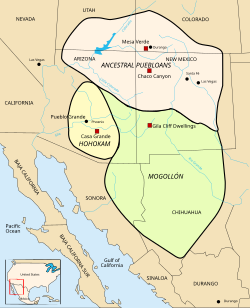| Ancestral Puebloan periods |
|---|
 |
| Archaic–Early Basketmaker 7000–1500 BCE |
| Early Basketmaker II 1500 BCE–50 CE |
| Late Basketmaker II 50–500 |
| Basketmaker III 500–750 |
| Pueblo I 750–900 |
| Pueblo II 900–1150 |
| Pueblo III 1150–1350 |
| Pueblo IV 1350–1600 |
| Pueblo V 1600–present |

The Basketmaker culture of the pre-Ancestral Puebloans began about 1500 BCE and continued until about 750 CE with the beginning of the Pueblo I Era. This prehistoric culture of Oasisamerica was named "Basketmaker" for the large number of baskets found at archaeological sites of 3,000 to 2,000 years ago.

